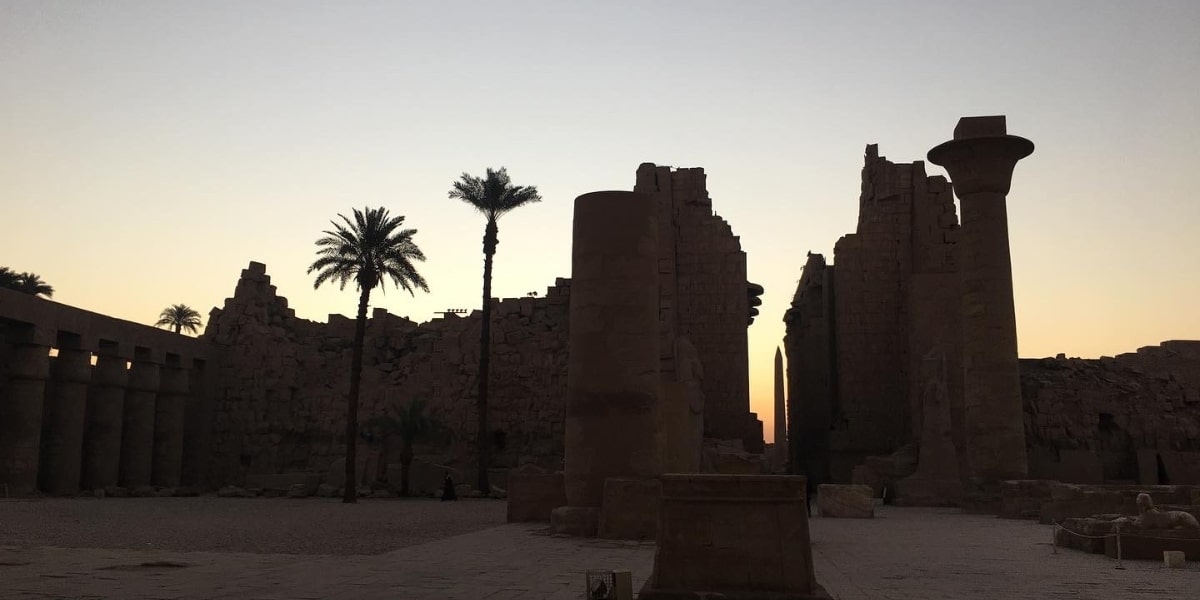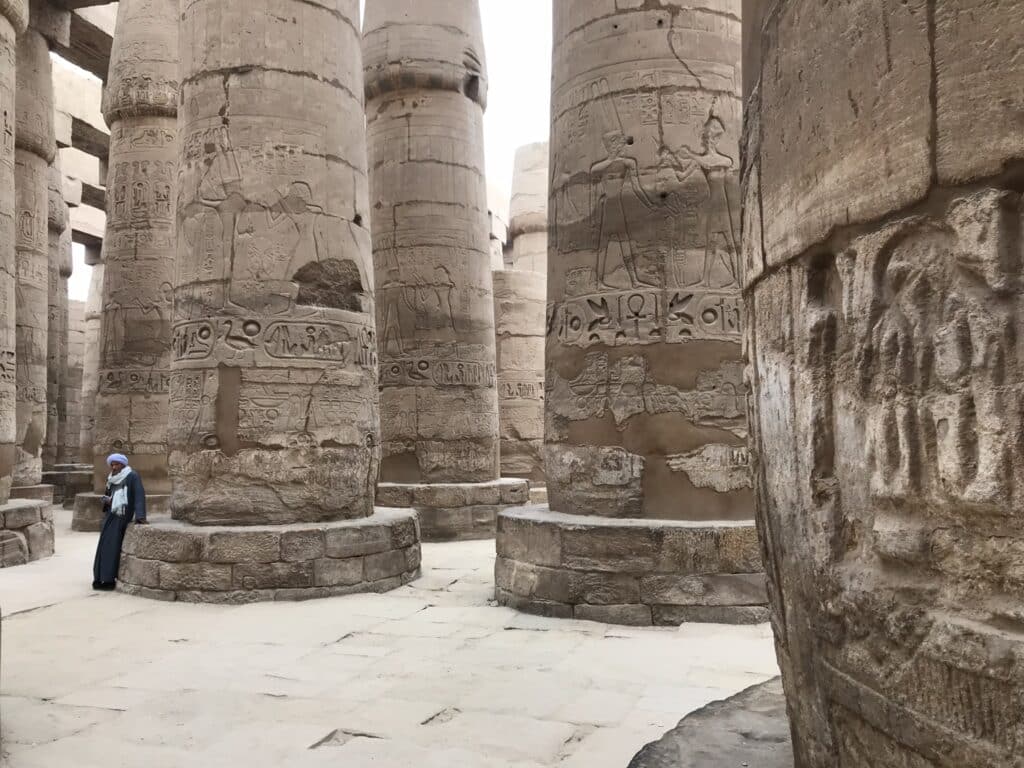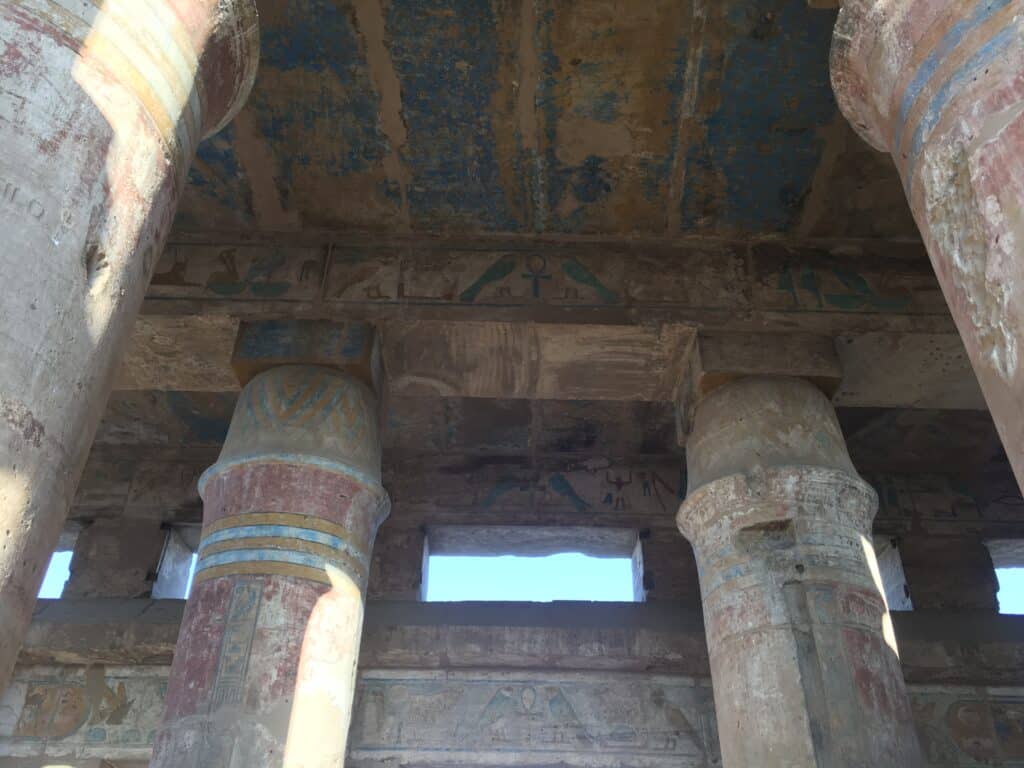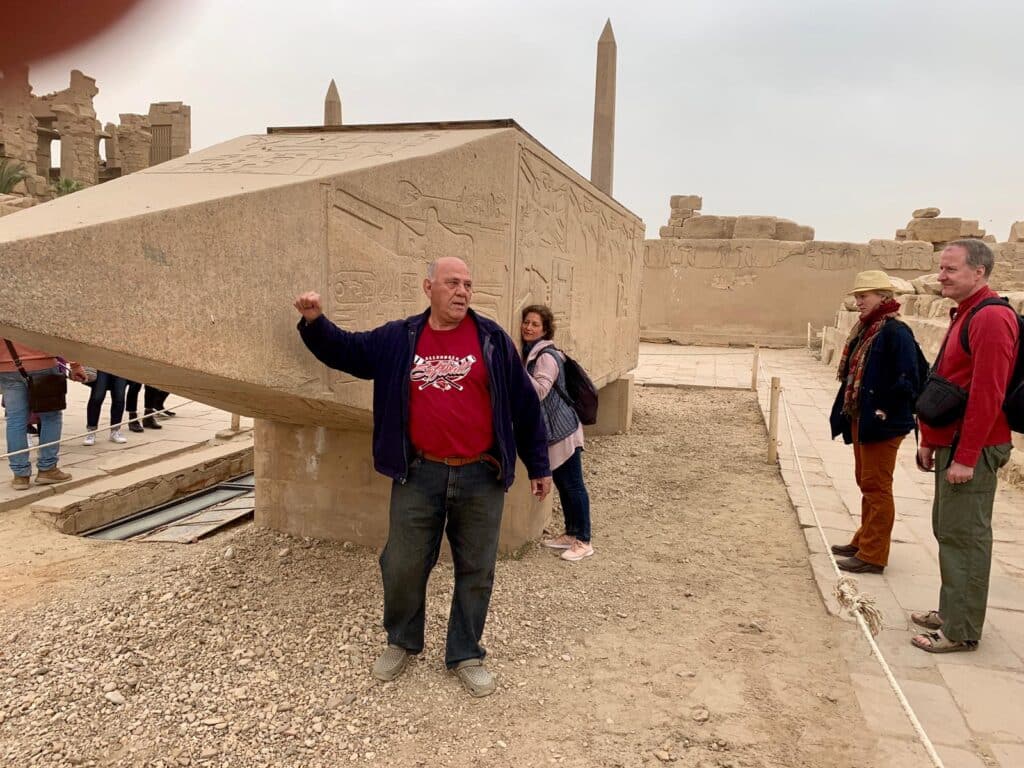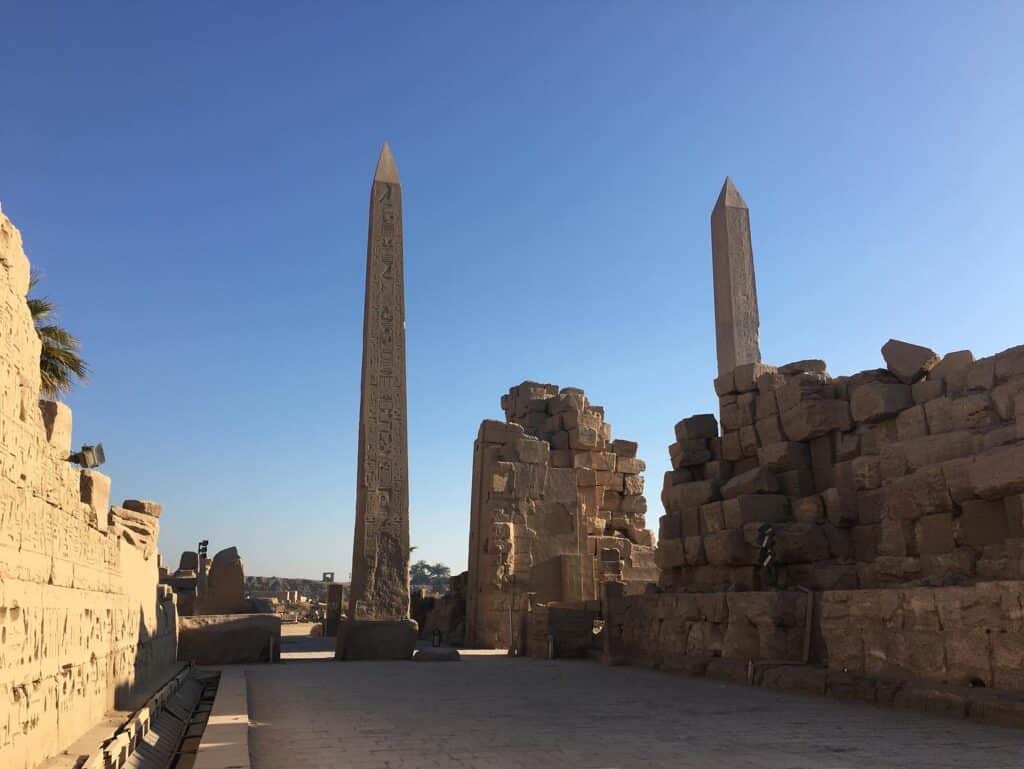Discover the magnetism of the Temple of Karnak, a sublime embodiment of ancient Egyptian spirituality, cosmology, and architectural brilliance.
The Enigmatic Temple Complex
I have visited the Temple of Karnak twice, even if I feel like I have been there several times over several centuries. It is a place where I feel at home, and it makes sense as my visit was with great friends and guided by Enneagram expert Russ Hudson.
(Listen to interviews with speakers and the conference board from the IEA Egypt Conference 2024)
In this article, my aim is to share some of my experiences, and if you are traveling to Egypt, then gift yourselves with a trip to Luxor and a visit to the Temple of Karnak. Go there in the morning before the traditional tourist gets there.
A profound radiance spills forth from the massive Temple of Karnak, holding in its grasp an intrigue that transcends millenniums. Woven into its massive columns and secret chambers and pathways is a mesmerizing allure that compels attention, making it one of the jewels of ancient Egyptian civilization to visit.
The Temple of Karnak, a jewel of ancient Egyptian civilization, embodies their spiritual beliefs and provides insight into their cosmic perception and societal structure.
This vast temple complex isn’t merely an abundant display of architectural brilliance but a sublime embodiment of the ancient Egyptians’ spiritual beliefs. As you explore the fascinating quarters, you glean a sense of their cosmic perception, their deities, and the intricate workings of their societal hierarchy.
The Origins of the Temple
The story of the Temple of Karnak unfolds like an epic, spanning over two thousand years and reflecting the religious beliefs of ancient Egypt. The temple was not built in a single shot but expanded by successive Pharaohs, echoing their respective reign’s unique ideologies.
Religion and a demonstration of power was the driving force behind the manifestation of Karnak. Dedicated to Amun, his wife Mut, and their son Khonsu – the Theban triad – the temple served as a beacon of illustrious devotion.
When you walk around the temple, you sense the different styles of architecture, and when we had some free time to walk around without our guides, I felt invited to find quiet places to sit and take in the different kinds of energies of the different parts of the temple.
If you are not that fortunate to have Russ Hudson to guide you, I will recommend searching for a guide that does not give you the traditional tour but knows where to look for the hidden gems of Karnak.
The Architectural Marvel of Karnak
The architectural expertise displayed at the Temple of Karnak is mind-blowing. The Egyptians displayed a deep understanding of geometry and engineering that rivals even modern capabilities.
Every stone, statue, and obelisk embodies dense symbolism. The architectural layout is not random; each structure stands to represent specific aspects of ancient Egyptian cosmology.
Intricate carvings etched on the temple’s walls vividly depict narratives of mythological stories, cosmic events, and religious rituals. These form a visual library of ancient Egypt’s spiritual heritage.
Unveiling the Temple’s Secrets
The Temple of Karnak, nestled in the ancient city of Thebes (Luxor), is draped in mystery and magnificence. This enormous complex, with its obelisks touching the sky and grand halls whispering the tales of time, harbors a celestial aura that invites exploration beyond the surface.
The Sacred Lake and its Symbolism
The Sacred Lake, profound in its symbolism, served as a divine cradle for ceremonial rituals. As daylight passed into the ink of night, the Egyptians believed the shimmering waters unlocked the sun god’s, Amon-Ra’s, transformative powers.
Delving into the spiritual significance, the Sacred Lake of Karnak mirrors the ancient Egyptian’s deep reverence for the interplay of natural elements. Its tranquil sprawl reflects not just physical skies but also a symbolic insight into the celestial landscape of their deities.
When I first walked around the lake, I did not understand its importance for ceremonial rituals. At first, it seemed like a great idea to have water inside the complex, but when I later was explained the importance of water, purification, and its life-giving nature, it seemed apparent or natural that the lake is more than just a water supply for the complex.
The Hypostyle Hall: A Forest of Columns
In between the towering stone structures, you’ll find yourself lost, deciphering hieroglyphics amidst the forest of columns, delving into the details of ancient stories etched in stone.
As your eyes adjust to the monumental scale, the grandeur of the Hypostyle Hall at Karnak becomes clear; its array of intricately carved columns stands as a silent testament to a fascinating chapter in the book of humanity’s architectural ingenuity.
I took some great photos there between the columns and imagined that I was back years ago where they probably would have been painted in strong colors with their own meaning and purpose.
The Botanical Garden of Karnak
Within the Temple of Karnak, there is a remarkable feature known as the Botanical Garden, which was created by the pharaoh Thutmose III. This unique addition to the temple complex showcases carvings of various plants and animals that the pharaoh encountered during his military campaigns.
The Botanical Garden offers a fascinating glimpse into the biodiversity and ecosystem of ancient Egypt. The intricate carvings depict a wide array of plant species, including trees, flowers, and shrubs, as well as different types of animals, such as birds, fish, and even insects. These carvings serve as a visual record of the natural world as it existed during Thutmose III’s reign.
The presence of the Botanical Garden within the temple is significant for several reasons. Firstly, it highlights the pharaoh’s appreciation for the natural world and his desire to document and preserve the flora and fauna he encountered during his conquests. It showcases the deep connection between ancient Egyptians and their environment, as well as their keen observation and understanding of the natural world.
Furthermore, the Botanical Garden provides valuable insights into the biodiversity of ancient Egypt. It allows us to study and understand the plant and animal species that thrived in the region during that era. This information is invaluable for researchers and historians, as it helps paint a more comprehensive picture of the ecosystem and natural resources available to the ancient Egyptians.
This remarkable feature adds yet another layer of fascination to the Temple of Karnak, making it a must-visit destination for those interested in ancient history, culture, and the natural world.
Beyond the Obelisks
Much of the history of the obelisks has faded into time’s shadow, yet each visible line resurrects forgotten legends and tales, reminding us of the stories that shaped ancient Egypt. The obelisks unveiled symbolize the celestial relationship between Egyptians and their gods, serving as a symbolic representation of the sun god, Ra.
Their pointed tops reaching out to the heavens, the obelisks force us to understand their profound significance. Their varying sizes and inscriptions showcase a narrative wherein the role of Pharaohs, their devotion to gods, and the grandeur of the empire become intertwined in the sands of time.
The Symbolism of the Obelisks
Obelisks, towering giants in the Karnak temple complex, were not merely architectural structures but deeply symbolic ones. Revered as petrified rays of the sun, they symbolized the divine connection between the temporal earthly realm and celestial eternity.
- The pointed pyramidal top, known as the ‘pyramidion,’ often coated with gold or electrum (a mix of gold and silver), symbolized the sun god Ra’s divine ray of light, broadcasting the Pharaoh’s eternal bond with the sun god.
- The hieroglyphs engraved on the obelisks reveal not just the histories of the pharaohs but offer glimpses into sacred rituals, celestial events, and religious beliefs of the ancient Egyptians.
- Pairs of obelisks were normal, as the pairs had an interconnected vibration and resonance connecting them into one instrument or greater of energy or vibrations.
The obelisk is carved out of one piece of granite, and when you put your ear to the stone and someone hits it with bare hands, it resonates with a deep, profound, and almost over natural sound.
I don’t know how to classify or explain the sound, but imagine when all obelisks were raised and then hit to share their specific resonance over the entire Temple of Karnak! The sound or vibrations might have been able to create a state of mind or heart that we are not used to engaging with in our modern lives.
The Lost Obelisks of Karnak
In addition to the obelisks that still stand in the Temple of Karnak, there are also notable obelisks that are no longer present. These missing obelisks hold their own intrigue and add to the rich history of the temple.
One such obelisk is the Luxor Obelisk, which now stands in the Place de la Concorde in Paris, France. Originally erected in Karnak, it was gifted to France in the 19th century. The Luxor Obelisk is a remarkable example of the ancient Egyptian obelisk tradition and serves as a testament to the global reach and influence of ancient Egyptian culture.
Another missing obelisk is the Obelisk of Thutmose I, which was relocated to the Hippodrome of Constantinople (now Istanbul, Turkey) during the reign of Emperor Theodosius I. Unfortunately, this obelisk was destroyed during the Fourth Crusade in the 13th century. Its remnants can still be seen in Istanbul today.
The missing obelisks of Karnak serve as a reminder of the global impact of ancient Egyptian culture and the enduring fascination with these monumental structures. Despite their physical absence, the legacy of these obelisks lives on, contributing to the allure and mystique of the Temple of Karnak.
Gurdjieff and the Symbolism of Karnak
“Beelzebub’s Tales to His Grandson,” written by George Ivanovich Gurdjieff, is a complex and allegorical work that weaves together Gurdjieff’s unique spiritual philosophy with numerous symbolic references. While the book doesn’t directly delve into the Temple of Karnak in a historical or archaeological sense, Gurdjieff uses the term “Karnak” in a symbolic manner, indicative of his style of embedding deeper esoteric meanings within his narratives.
While the actual Temple of Karnak was a central religious and cultural site in ancient Egypt, Gurdjieff’s use of the name for an observatory suggests a metaphorical or symbolic interpretation rather than a direct representation.
Gurdjieff’s choice to name this observatory “Karnak” could be seen as a reflection of his views on the universality and interconnectedness of ancient wisdom and cosmic truths. The Temple of Karnak, known for its astronomical alignments and spiritual significance in the ancient world, serves as an apt symbol for a place of observation and reflection in Gurdjieff’s narrative. It’s as if he’s drawing a parallel between the ancient Egyptian’s celestial observations and spiritual pursuits and Beelzebub’s extraterrestrial observations of humanity.
Furthermore, Gurdjieff’s work often challenges readers to look beyond literal interpretations and to find deeper meanings and connections. His use of names and places from our world in a recontextualized, cosmic setting is part of this method. It prompts readers to consider the broader implications of these symbols in the quest for spiritual understanding.
Other suggestions while in Luxor
If you are visiting Luxor, then I would recommend also visiting Luxor Temple. I have been there in the evening when the tourists are fewer and the colors of the night make everything even more magnificent. Also, the Luxor Museum is an extraordinary experience that is a “must” when in Luxor. I have seen hot air balloons rising in the morning over Luxor but never had the chance to experience it, but that’s on my list when visiting Luxor the next time.
(Read more about trips to book, when in Egypt for the Conference 2024)

